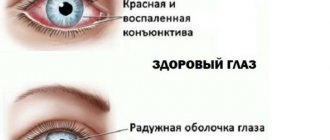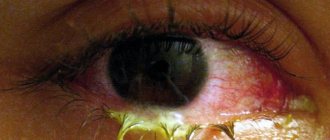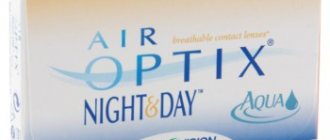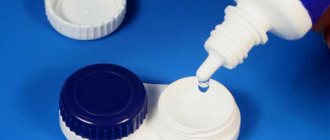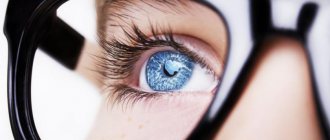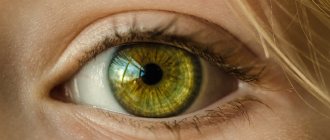132
Author of the article
Tsareva Elena Vladimirovna
Reading time: 10 minutes
A A
An aqueous solution of Chlorhexidine is used to wash the eyes and treat the eyelids for complicated (purulent) conjunctivitis. The product is quite concentrated, it should be used only on the recommendation of a specialist with great caution. It is necessary to take into account age, diagnosis, degree of damage to the conjunctiva, and it is also important to strictly follow the instructions for use of the drug.
- Description and composition of the drug
- Medicinal properties and principle of action
- Indications
- Contraindications
- Reaction and side effects
- Preparation
- Features of use in adults
- Use in children
- For different types of illness
- Bacterial
- Viral
- Allergic
- Purulent
- Price and analogues
- Conclusion
Description and composition of the drug
Chlorhexidine is a powerful antiseptic (anti-putrefactive agent), used topically, externally. The drug became widespread in world practice back in the 50s. 20th century. Its high effectiveness as an antibacterial agent in the treatment of urological, dental, gynecological, and ophthalmological diseases has been proven.
Available in the form of alcohol and aqueous solutions with varying concentrations (from 0.05% to 1%), suppositories, gels, tablets and aerosols.
An aqueous solution is a clear, colorless or yellowish liquid. It does not have a pronounced taste or smell. Does not leave marks or scars on the skin. In the absence of allergies, it does not cause painful or unpleasant sensations, does not irritate the skin, and thereby does not inhibit healing.
Packaged in plastic or glass bottles with an airtight lid of 100, 200 ml and 1 l.
Compound:
- the main active ingredient is chlorhexidine bigluconate (dosage depending on the required concentration of the drug);
- purified water.
Expert opinion
Ermolaeva Tatyana Borisovna
Ophthalmologist of the highest category, Candidate of Medical Sciences
Bigluconate (organic gluconic acid) is an important intermediate product of carbohydrate metabolism in living cells; Produced by living organisms, it has beneficial effects.
A product with a concentration of 0.05%, 0.1%, 0.2% is intended for disinfection of wounds, burns, and purulent formations.
More concentrated solutions are used for processing and sterilizing medical instruments.
Is it possible to wipe your eyes with chlorhexidine?
Doctors recommend Chlorhexidine solution for washing the eyes to prevent and treat inflammatory processes of an infectious and bacterial nature. A strong antiseptic effect quickly eliminates the symptoms of ophthalmic diseases.
The use of the medicinal solution has no age restrictions and rarely causes side effects if the dosage and concentration are strictly observed.
However, in case of serious pathologies of the visual organs, it is recommended to consult an ophthalmologist before use.
Composition and action
The drug solution is applicable not only to humans, but is also used in veterinary medicine. Chlorhexidine effectively treats eye diseases in dogs and cats. Animals' eyes should be treated if an inflammatory process occurs with the release of pus or mucus.
Pharmacies usually sell a 0.05% solution, which can be instilled into mucous membranes without additional dilution.
The liquid, colorless or with a slight yellow tint, without a characteristic odor, consists of the active substance chlorhexidine digluconate and distilled water. The optimal ratio is 1 to 2.
The remedy has the following positive effects on the human visual organs:
- antiseptic;
- disinfectant;
- antibacterial.
Indications for use
The product will help stop the spread of bacterial infection.
Ophthalmologists recommend rinsing your eyes with Chlorhexidine or dripping the solution onto the mucous membrane in the following conditions:
- conjunctivitis;
- iritis and choroiditis;
- blepharitis;
- redness and swelling of the eyelids;
- swelling of the vascular network;
- keratitis;
- formation of purulent discharge;
- burning and itching in the eyeball;
- foreign body sensation;
- acute pain syndrome.
Can it be used on the eyes?
Chlorhexidine is an effective eye treatment for preventive and therapeutic purposes.
If the drug gets on the mucous membranes, there are no negative consequences, since the substance has a disinfecting effect.
Most often, drops are used for ophthalmic diseases, but compresses and washing the organ of vision are also useful. The procedure is used even for conjunctivitis in newborns, but with a reduced concentration of the active substance.
Instructions for use
Getting the product inside the eye can cause a burn to the mucous membrane.
When treating the eyes, a diluted solution of the drug is used, while children are recommended to use a concentration 2 times less than for adults. Pharmacies sell liquids containing 0.02% or 0.05%. When applying compresses, the following instructions for use are recommended:
- The medicinal solution is heated in the palms to room temperature.
- Eyes close tightly.
- Careful movements are made with a damp cotton pad from the outer corner to the lacrimal canal. It is not recommended to get liquid on mucous membranes.
- The optimal number of repetitions is 5-6 times a day. The eyes of a newborn can be wiped 2-3 times until the negative symptoms disappear.
If pure Chlorhexidine gets into the eyes, it will not cause pathological changes and will not damage the retina. It is enough to treat the mucous membrane with cool water from a kettle. It is not recommended to use flow-through, especially when providing care to newborns, to avoid infection.
The child is recommended to drip the solution into the corner of the eye. The optimal dosage is 1-2 drops. It is recommended to repeat the procedure up to 3 times a day, depending on the symptoms of the disease. You can instill it using a syringe, after removing the needle.
After this, it is recommended to close the eye and lightly massage the eyelid so that the liquid is evenly distributed over the mucous membrane. Strong pressure is contraindicated. It is important to pre-treat your hands with disinfectant.
However, soap or shower gel are not suitable; the optimal solution is alcohol.
Are there any restrictions?
People prone to allergic reactions are advised to discuss the use of the drug with a doctor.
Despite the effectiveness of the antiseptic, it is not recommended for use by allergy sufferers due to possible individual intolerance to the components of the composition.
Young children under 6 years of age should carefully calculate the dosage and use the lowest concentration so as not to cause a burn to the retina, which can impair vision. Additionally, rinsing your mouth and nose with the product is contraindicated.
Pregnant women, due to hormonal changes, are advised to consult a doctor before use.
Compatibility with other drugs
The simultaneous use of Chlorhexidine and products containing iodine is contraindicated, as it can lead to dermatitis. The drug is incompatible with soap, shampoo and anionic antiseptics.
It is recommended to check the list of medications with your therapist. In this case, ethanol can increase the effectiveness of the drug.
Contact of Chlohexidine with carbonates, phosphates and sulfates should be avoided, as a precipitate will form and the product will become unsuitable for use.
Analogue drugs
The drug has an antiseptic and local anesthetic effect.
As an alternative, when diagnosing an allergic reaction, ophthalmologists recommend medications that have a similar effect. However, before use it is necessary to study contraindications. The most effective antiseptics for the organs of vision include the following:
- "Instillagel";
- "Baktosin";
- "Citeal";
- "Mukosanin."
Consequences of overdose
If you drop pure or slightly diluted Chlorhexidine into the mucous membranes of the organ of vision, a chemical burn of the retina may occur. Characteristic symptoms include itching, burning, pain and increased lacrimation.
You should immediately rinse your eyes and consult an ophthalmologist if symptoms do not go away within 1-2 hours. The dangerous consequences of a burn are deterioration of visual abilities and damage to the sclera, requiring medical treatment.
In case of overdose, wiping your eyes with your hands or a towel is prohibited, as this can further damage the cornea and cause infection.
Source: https://EtoGlaza.ru/izlechenie/obschee/mozhno-li-hlorgeksidinom-promyvat-glaza.html
Medicinal properties and principle of action
For conjunctivitis, it is permissible to use only aqueous solutions of Chlorhexidine (0.05% or 0.02%).
Firstly, Chlorhexidine is a powerful local antiseptic that has a bactericidal effect (blocks the proliferation of pathogenic microorganisms and destroys them).
Secondly, the drug has a fungicidal effect (destroys spores of dangerous fungi).
In addition, the virucidal effect of Chlorhexidine is noted (effective against various viruses of hepatitis, herpes, etc.).
Mechanism of action of the drug: damages harmful bacteria and viruses at the cellular level and promotes their death.
Peculiarities:
- after treatment, it retains its medicinal properties quite stably;
- remains active for a long time (up to 5 - 6 hours);
- not absorbed into the blood when used topically;
- in the absence of contraindications, the product is harmless to the body (does not cause addiction or systemic effects).
You can treat the surface of the eyelids with the product only on the recommendation of a doctor.
Expert opinion
Ermolaeva Tatyana Borisovna
Ophthalmologist of the highest category, Candidate of Medical Sciences
You need to know that the drug is strong; diluting it yourself or “bringing it” to the required concentration is strictly prohibited (only ready-made solutions are used). May cause burns to the mucous membrane.
conclusions
Friends, an aqueous solution of Chlorhexidine helps in the treatment of conjunctivitis and other infectious and inflammatory diseases of the organs of vision - this has been proven in practice. However, it must be used only as prescribed by an eye doctor, since the medicine is potent.
This will avoid unwanted reactions from the visual system and the body as a whole. If the information was useful to you, please share it with your friends, comments and reviews about the drug are also welcome. All the best and see you again on the pages of our website!
Conjunctivitis is an inflammatory process affecting the mucous membrane of the eye, which is most often caused by viruses and bacteria. It can also be caused by an allergic reaction. Treatment of the disease, especially in children, is urgent. It should be supervised by an ophthalmologist and include the use of medications and auxiliary local procedures. Therefore, it is useful for parents to know what and how to wash their eyes with conjunctivitis, so that positive dynamics do not take long to appear.
Why do you need eye wash?
Washing the eyes using medications or traditional medicine allows you to solve three problems at once:
It is necessary to carry out this procedure before instilling drops and applying ointment - this way the active ingredients of the drugs can get onto the mucous membrane. If you neglect to wash your eyes, the healing process will be significantly delayed.
How to perform the procedure correctly?
How to properly rinse a child's eyes? There are several ways. But children, especially young children, do not tolerate baths or rinsing with a stream of water. A more gentle procedure is compresses made from soaked cotton or gauze swabs or bandages. They are soaked in liquid and then applied to closed eyelids to soak dried crusts of pus. Next, you will need another wet swab, which is squeezed over the open eye. You can gently rub your eyes without force to remove all dirt.
Before preparing the solution, wash your hands well with soap. The dishes must be clean, and the water must be boiled or distilled. When rinsing is completed, you should immediately throw away the tampons and wash your hands again.
5 best eye washes for conjunctivitis
To wash your eyes, you can buy medications at the pharmacy or use proven traditional medicine recipes. Their effectiveness has been proven not only by experience: ophthalmologists often advise their patients to use herbal products because they have an anti-inflammatory effect and kill pathogenic microorganisms.
Chamomile is a natural antiseptic. It can be bought at a pharmacy at an affordable price. To prepare an infusion that is suitable for washing the eyes of conjunctivitis, even for infants, you need to put 3 tablespoons of dried flowers in a bowl and pour 250 ml of boiling water (1 cup) over them. Leave for 1–1.5 hours, tightly closing the container with a lid. Then strain the infusion through several layers of gauze.
Black tea for washing eyes is perhaps the most famous folk remedy in the fight against ophthalmological diseases. This remedy perfectly relieves inflammation. Simply brewing strong tea is enough. The liquid should be prepared 10–15 minutes before use so that it has time to cool to a comfortable temperature.
Furacilin perfectly destroys bacteria. It can also be used for very young children. There is a ready-made solution and furatsilin in tablet form on sale. It is better to choose the second option, because this will always allow you to produce a fresh drug in the right quantity. For each wash, it is recommended to prepare a new product.
Two simple recipes for furatsilin solution:
- Pour half a glass of boiling water over the tablet and leave until it completely dissolves.
- Pre-grind the furatsilin to make a powder and stir it in warm water.
To ensure that there are no large particles in the solution, the liquid is filtered.
Chlorhexidine is sold in pharmacies in the form of 0.02% and 0.05% aqueous solution. The second type is used for ophthalmological diseases. If you need to rinse your child’s eyes, chlorhexidine 0.05% should be diluted by another half.
It is not recommended to use chlorhexidine in children under 12 years of age. Also, if after instillation the patient complained of a strong burning sensation, it is better to give preference to Miramistin, which has a milder effect on the tissue.
Miramistin has two important advantages over other drugs - it destroys not only bacteria, but also viruses; and also promotes rapid tissue regeneration. To wash the eyes, use a 0.01% aqueous solution of Miramistin. It can be used by both pregnant women and young children because it is safe.
How other mothers wipe their children’s eyes with conjunctivitis (video):
What products do you use to wash your eyes for conjunctivitis? Do they bring relief? Tell us about your experience in the comments to this material.
What kind of drug is Chlorhexidine?
This drug belongs to the group of antiseptic drugs. Chlorhexidine is classified as a drug used as a topical antiseptic. That is, it is used to treat the surfaces of the skin and mucous membranes. Chlorhexidine is widely used as a bacteriostatic and disinfectant.
Due to its composition, Chlorhexidine has a highly effective effect on gram-positive and gram-negative flora. A huge advantage of Chlorhexidine is its high efficiency in an environment where blood masses and exudate are present.
It is also important that Chlorhexidine acts on the integument and mucous membranes for a long time after application to them. In addition, Chlorhexidine solution can inhibit the growth and reproduction processes of microorganisms.
Areas of application of Chlorhexidine
Chdorgexidine and its drugs, for example Miramistin, are widely used in medicine to treat intact and damaged surfaces and mucous membranes of the body. It is also used to disinfect medical instruments in cases where thermal treatment methods can damage the instrument or equipment.
Based on the above information, it turns out that Chlorhexidine can be used for the eyes. For example, Chlorhexidine is used as a local antiseptic for conjunctivitis. It is used as a means for washing the conjunctival sac.
In addition to the use of Chlorhexidine in the treatment of eye diseases, it is used in veterinary medicine. Chlorhexidine can be dropped into the eyes of pets, such as dogs or cats (including kittens and puppies) to treat inflammatory diseases (inflammation of the mucous membranes).
Once again about where the drug is used. It is used for:
- Treatment of damaged and undamaged surfaces of the skin and mucous membranes;
- For processing medical instruments and equipment;
- For the treatment of inflammatory diseases;
- To prevent the development of infectious processes.
How to rinse eyes with Chlorhexidine
If there is a need to treat the eyes with Chlorhexidine, it must be diluted with water. When first used to wash the eyes, Chlorhexidine, in addition to being diluted in warm water, must be dripped under the conjunctiva. This is indicated if the drug is used to treat a child, because his health is more susceptible to any negative influence factors.
You can wipe your child's eyes with Chlorhexidine if there is discharge from the conjunctival sac. This can be either mucous or purulent discharge. Eye treatment should be carried out with a warm solution. To do this, it is heated to body temperature. Take cotton wool or a cotton swab and moisten it in a solution of Chlorhexidine. Under no circumstances should Chlorhexidine be poured into the eyes. This may cause unwanted effects, such as chemical damage to the eye.
Answer to your question
Considering the chemical nature of Chlorhexidine, the indications for its use and the effect on biological tissues, we can say that this drug can be used to wash the eyes. However, you should adhere to the rules for using the drug so as not to damage your eyes.
If burning or pain occurs in the eye caused by Chlorhexidine, the eyes should be immediately rinsed with plenty of warm water. After this, it is advisable to seek medical help from an ophthalmologist.
Found a mistake? Select it and press Ctrl + Enter
Chlorhexidine, or Chlorhexidine digluconate, in the language of pharmacists, is a popular antiseptic widely used in medicine. It is usually used to treat stomatitis and ENT diseases. The solution quickly destroys pathogenic microflora, relieves pain, inflammation and prevents recurrent infection. Patients who have tried it at least once no longer want to switch to another antiseptic drug for infections of any origin. But is it possible to wash your eyes with Chlorhexidine for conjunctivitis, blepharitis and other infectious eye diseases?
Note: Chlorhexidine is a fairly new antiseptic that only recently appeared in the home medicine cabinets of our compatriots, replacing the traditional iodine and brilliant green. The drug was discovered in the middle of the last century in Great Britain. It was not immediately used to treat various fabrics and surfaces for the purpose of disinfection, since the properties of this substance were little studied. But now Chlorhexidine is a favorite antiseptic drug for versatile use for many doctors and patients.
Indications
The product is used as a variable, as a disinfectant and antiseptic:
- to prevent the spread of infection (herpes, Staphylococcus aureus, chlamydia, gonococcal infections);
- for disinfection in case of purulent inflammation and gluing of the eyelids, redness, swelling;
- when treating cracks and damage to the skin of the eyelids;
- for external disinfection during the formation of ulcers, fungal diseases of the skin and mucous membranes (for stomatitis, gingivitis, purulent tonsillitis);
- in gynecology (chlamydia, syphilis, genital herpes);
- when processing medical instruments, equipment, hands.
Expert opinion
Ermolaeva Tatyana Borisovna
Ophthalmologist of the highest category, Candidate of Medical Sciences
There are no direct indications for use in the treatment of conjunctivitis with this drug.
Contraindications
The use of Chlorhexidine is not recommended:
Have you used Chlorhexidine solution for conjunctivitis?
Not really
- pregnant and lactating women;
- The drug is contraindicated for children under 12 years of age;
- in the presence of contact dermatitis and other skin inflammations;
- patients suffering from allergies (eyes can be washed only after special tests for allergens);
- treatment of the conjunctiva itself and the conjunctival sac of the eye is unacceptable;
- cannot be used in combination with soap.
What else is important to know
Typically, Chlorhexidine solution combines well with other medications. But in some cases caution should be exercised.
- The substance does not combine with soap, since soap is alkali, and Chlorhexidine contains chlorine. Before carrying out the necessary manipulations, you should definitely wash your hands with soap, but then you need to rinse them well under running water and wipe them thoroughly dry. If Chlorhexidine solution is used to disinfect hands, then you should no longer wash them with soap.
- The drug interacts with such a popular home antiseptic as iodine. The simultaneous use of two medicines may cause skin dermatitis.
- When combined with ethyl alcohol, the therapeutic effect of Chlorhexidine is enhanced. For this reason, predominantly an alcohol solution of the drug is available in pharmacies. But for the same reason, it is not recommended for use in pediatrics and for the treatment of women during the period of bearing and feeding a child.
An opened bottle or container with a solution prepared independently is stored in the refrigerator for no more than one week. Then the remaining product should be disposed of and a new portion should be prepared. When sealed at a temperature not exceeding 25 degrees Celsius, it can be stored for up to three years without losing its properties.
An analogue of Chlorhexidine solution for the eyes are Miramistin or Okomistin drops.
Summary: Chlorhexidine is a relatively new broad-spectrum antiseptic drug. It is used as a disinfectant for treating purulent wounds, skin and mucous membranes, disinfecting hands and medical instruments. Since the substance contains chlorine, it is not recommended for use in ophthalmology: Chlorhexidine can cause burns to the cornea. But if you dilute the drug with water to a weak concentration, you can wash your eyes with it for purulent conjunctivitis and other infections caused by the introduction of bacteria, some fungi and viruses. The medicine is available in pharmacies without a doctor's prescription. But this does not mean that it can be used uncontrolled; consultation with an ophthalmologist before starting a course of treatment is necessary, especially if we are talking about children under 12 years old, pregnant or lactating.
Reaction and side effects
If the instructions (dosage and method of treatment) are followed and there are no contraindications, patients, as a rule, do not experience pain.
Possible adverse reactions:
- allergies (skin rashes);
- short-term burning sensation;
- severe itching;
- swelling;
- involuntary lacrimation;
- irritation (redness of the eyelids).
Expert opinion
Ermolaeva Tatyana Borisovna
Ophthalmologist of the highest category, Candidate of Medical Sciences
At the first manifestation of negative reactions, you must inform your doctor; the drug is discontinued and replaced with another antiseptic.
Features of use in adults
Only an aqueous solution of Chlorhexidine 0.01 or 0.05% (without alcohol) is used.
Rules:
- the patient closes his eyes;
- for processing you can use a cotton pad or gauze swab, ear sticks;
- the tampon is moistened with a warm solution;
- treat the eyelids strictly in the direction from the outer corner to the inner corner (at the bridge of the nose);
- soaked purulent crusts are carefully removed;
- the procedure is performed for at least 4-5 rubles. in a day.
Expert opinion
Ermolaeva Tatyana Borisovna
Ophthalmologist of the highest category, Candidate of Medical Sciences
In case of contact with the mucous membranes of the eyes, it is necessary to immediately rinse the eyes with running water; If you accidentally swallow the solution, you should drink a glass of warm water to reduce the concentration of the drug in the stomach.
Chlorhexidine for the eyes, can it be washed or dripped into the eyes?
In every home medicine cabinet, among the basic medicines, there is an antiseptic, which is used to provide first aid for injuries and various types of skin injuries.
Chlorhexidine is especially popular due to the wide spectrum of action of its constituent components.
The following discusses possible options for using a disinfectant solution in everyday life, as well as rules for use.
Can Chlorhexidine be used on human eyes (rinse or drop)
The annotation for the drug states that it is undesirable to allow the solution to come into contact with the mucous membranes during its use. Basically, this warning applies to concentrated formulations, which can cause severe burning or even burn the eyes. If low concentration Chlorhexidine is used for procedures, then the use of the drug in ophthalmology is quite acceptable.
To wipe, wash or treat the eyes, you need to choose only an antiseptic of 0.02% or 0.05%. The first option is prepared at home from a 0.05% pharmaceutical product. To do this, it is enough to dilute it with purified water in the same amount as the drug. For treating the mucous membranes of adults, an undiluted composition is more suitable; children should only be washed with a weak solution.
Treatment is performed using a cotton pad soaked in antiseptic. The number of procedures per day is at least 4-5 times to achieve a therapeutic effect.
The essence of the treatment is to pass a swab over a closed (not tightly) eye in the direction from the outer corner to the inner one.
The aqueous solution does not cause harm to the organ of vision, but you should try to avoid getting the product into the eyeball.
Reference! With conjunctivitis, both eyes are affected, but the process of disease development occurs at different rates. Therefore, both organs of vision are subject to treatment.
Pregnant women and children should use Chlorhexidine for the eyes only with the consultation of a doctor.
An antiseptic is a fairly aggressive substance, so you need to clarify with a specialist the nuances of use and the concentration of the solution. Only aqueous composition is suitable for procedures.
Preference is given to drugs diluted in a pharmacy, the label of which indicates the percentage of concentration.
Important! Chlorhexidine can be used to treat the eyes of children from the age of 12.
The active substance penetrates the bloodstream in small quantities, so it cannot harm a pregnant woman, or rather the fetus. Alcohol solutions have a high chance of entering the bloodstream, and there is a risk of side effects. Therefore, alcohol-based drugs are prohibited for use by pregnant women and infants.
Reference! It is impossible to instill an undiluted antiseptic solution into the eyes.
For infants, Chlorhexidine is considered too strong and can cause eye injury. Therefore, pediatricians recommend wiping the mucous membrane using safe and no less effective methods (chamomile decoction, Furacilin solution, etc.).
The antiseptic is also used in veterinary ophthalmology, but in diluted form. To wash the eyes of a cat or dog, you need to prepare a solution of purified water (room temperature and Chlorhexidine). Both components are taken in equal proportions.
The concentration of the active substance of the antiseptic should initially be 0.05%. The result is a disinfectant liquid of 0.02%. The procedure itself is performed using a syringe without a needle.
The animal's eyes are generously irrigated with the prepared product, then wiped with a cotton swab dipped in the same solution.
Composition of the drug
The antiseptic is available in the form of an alcohol- and water-based spray. The basis of the composition is chlorhexidine bigluconate. Depending on the type of solution, the active substance (5 g) is diluted with ethanol (95%) or water (718.5 ml) to obtain 1 liter of disinfectant liquid.
Mechanism of action of Chlorhexidine
The operating principle of the active component of the antiseptic is to interact with phosphate substances on the surface of the cell, as a result of which its integrity is disrupted, which leads to the death of the bacterium.
Low concentration solutions block the passage of ions through the membranes of pathogenic cells. This creates a bacteriostatic effect. When the concentration increases to 0.01%, the cell walls lose their integrity, resulting in the death of the microorganism.
Reference! If suppuration forms at the site of damage, bloody discharge is present, the effectiveness of the antiseptic is slightly reduced.
Areas and indications for use
Due to the unique properties and versatility of the drug, it can be used in various fields.
- In the treatment of ENT diseases.
- In dentistry (rinsing to disinfect the mucous membrane and surfaces of dental tissues).
- In gynecology for the treatment of infectious and inflammatory processes.
- In urology to eliminate inflammation in the urinary tract (in men and women).
- In traumatology for the treatment of various soft tissue injuries, burns, etc.
- For treating the hands of medical personnel and instruments.
This is only a small part of the full list of areas where an antiseptic solution is used as a priority option. In addition to medicine, the drug is used in the food industry to disinfect work surfaces, in cosmetology, and in public utilities.
How to properly apply Chlorhexidine eye drops
The annotation for the drug states that the solution should not get into the eyes when treating wounds and injuries. Some experts recommend an antiseptic for wiping and washing the eyes. However, Chlorhexidine has shown effectiveness in the treatment of various types of conjunctivitis and inflammatory diseases of the organ of vision.
The main thing when instilling is to follow strict rules, and then discomfort is reduced to a minimum, and the risk of injury is zero. This method can only be used as prescribed by a doctor.
Step-by-step instruction
- Prepare everything you need for pre-disinfected distribution. Wash your hands thoroughly.
- Pipette the antiseptic, first checking the concentration of the solution on the label. For instillation it is allowed to use only 0.02 and 0.05% formulations.
- Warm the prepared dose with your hand to body temperature.
- Tilt your head up or take a lying position. Move the index finger of your free hand to the middle of the lower eyelid and introduce 1 drop of antiseptic.
- Using your index finger, lightly press on the lacrimal punctum and hold it there for about 1 minute.
- Do the same with the second eye.
Precautionary measures
It is important to follow the following safety precautions when using Chlorhexidine.
- Strongly concentrated solutions or alcohol-based formulations should not be used to treat the organ of vision.
- More than one drop should not be administered under the conjunctiva.
- After instillation, you need to blink your upper eyelid several times to distribute the liquid over the entire surface.
- Before the procedure, the antiseptic is warmed up with your hand so as not to chill your eyes.
- If the dose is exceeded, it is recommended to rinse the mucous membrane with plenty of warm water.
- Chlorhexidine should not be used for treatment for a long time. If the medicine does not have an effect after several instillations, you need to contact an ophthalmologist to select a more effective remedy.
In practice, the effectiveness of using antiseptics in ophthalmology has been proven. However, the drug must be used according to the described rules without making unreasonable adjustments. Sometimes minor changes to a procedure result in a lengthy process of eliminating the consequences.
Watch a video about other ways to use Chlorhexidine:
Select it and press Ctrl+Enter to let us know.
Source: https://glaza.online/pr/hlorgeksidin-dlya-glaz.html
Use in children
An eye antiseptic is used to clean a child's eyes. When is it used? As soon as conjunctivitis begins, and the child rubs his eyes vigorously. There is a possibility that an infection will occur, so for preventive purposes you need to treat your eyelids and rinse your eyes. But can children use Chlorhexidine?
Leading pediatricians do not recommend its use for young children (under 10-12 years of age it should not be used at all) . For example, Dr. E. Komarovsky advises washing children’s eyes with a regular saline solution, or you can use chamomile decoction or tea leaves.
A detailed article about methods of treating conjunctivitis with folk remedies.
How to use the drug correctly
So, high concentration Chlorhexidine is not suitable for dripping directly into the conjunctival sac. A solution of even the lowest concentration can cause severe chemical burns to the mucous membrane and damage to the cornea. But you can instill it in diluted form, wipe the eyes of a child or adult, and also use it as antiseptic eye drops to wash the eyes.
How to do it correctly:
- Before instillation, be sure to rinse your eyes to remove purulent discharge and crusts. For this purpose, use warm boiled water, chamomile decoction or a weak solution of furatsilin, cotton pads or swabs. Then Chlorhexidine is diluted with warm boiled water. For an adult, a concentration of 1:1 is sufficient. For children, the concentration should be two times lower. The drug is injected into the conjunctival sac, slightly retracting the lower eyelid, in the amount of 2-3 drops. The frequency of administration of the drug per day is no more than 3 times.
- To clear pus from the eyes, Chlorhexidine is first warmed to body temperature. The eyes should be treated with a cotton swab dipped in a solution of Chlorhexidine. If your child's eyes are washed, you should first test the effect of the drug on yourself. If the solution is too concentrated, it is diluted with water. It is forbidden to pour even a diluted solution into your eyes - this can cause a burn. You can rinse and clean your eyes with a diluted solution up to six times a day.
For different types of illness
Next, we will consider the possibilities of using Chlorhexidine solution for various types of conjunctivitis.
Bacterial
Bacterial conjunctivitis can only be eliminated with antibacterial agents (drops and special eye solutions). Treatment of an infection that causes acute inflammation is complex. Drops of zinc sulfate, boric acid 2%, Oftalmodek (sterile eye solution) in combination with eye antiseptics (including Chlorhexidine) relieve pain, swelling and destroy infection.
Viral
If there is a thick, viscous or purulent discharge, it is necessary to rinse the eyes with an antiseptic.
Scrapings, skin tests and tests are taken to identify the virus as the source of conjunctivitis.
Allergic
With spring and drug eye allergies, first of all, the allergen that causes inflammation of the conjunctiva is excluded. If the discharge is clear, without pus, then additional bactericidal agents are not prescribed. Therapy is carried out with antihistamines.
With hyperpapillary allergic or infectious-allergic conjunctivitis, infection is present (as a secondary symptom). The discharge takes on a grayish or yellow tint and becomes viscous. Here it is necessary to additionally use eye antiseptics to treat the edges of the eyelids.
For seasonal allergies, multifunctional drops (Albucil, Okumetil) are used. They also have an antiseptic effect (relieve inflammation and irritation) and constrict blood vessels (eliminate the root cause of allergies).
Purulent
Chlorhexidine for eye rinsing is most often recommended in the presence of purulent formations. The product softens purulent crusts, cleanses the eyelids, promotes rapid healing of microcracks in the skin of the eyelids, and stops the proliferation of bacteria.
Price and analogues
Did Chlorhexidine solution help you in the treatment of conjunctivitis?
Not really
Price:
- Chlorhexidine bottles 0.05%, 100 ml (Biogen), 15 rub.
- Chlorhexidine Vialine (solution) 200 ml, 113 rub. (in addition to the main active ingredient, the composition contains lemon extract, which relieves inflammation).
- Chlorhexidine (alcohol solution) 0.5%, 1 l, 184 rub.
Analogues:
- Boric acid, 2%, up to 50 rubles - antimicrobial agent.
- Furacilin powder (for preparing a solution), 20 mg, 10 pcs., 60 rub. – used to wash the eyes, easily removes suppuration.
- Miramistin, 0.01% (solution for topical use), bottle with dropper, 50 ml, from 200 rubles - used as part of complex therapy and for preventive purposes (purulent wounds and skin suppuration).

